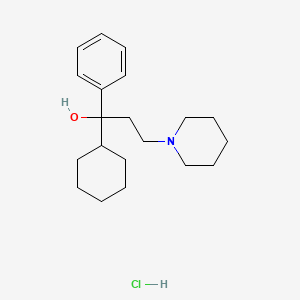



1. Apo Trihex
2. Apo-trihex
3. Apotrihex
4. Artane
5. Benzhexol
6. Cyclodol
7. Hipokinon
8. Parkinane
9. Parkopan
10. Trihexane
11. Trihexidyl Hydrochloride
12. Trihexyphenidyl
13. Trihexyphenidyl Hydrochloride Elixir
1. Benzhexol Hydrochloride
2. 52-49-3
3. Artane
4. Trihexyphenidyl Hcl
5. Cyclodol
6. Parcopane
7. Romparkin
8. Tremin
9. Benzhexol Hcl
10. Artane Hydrochloride
11. Triesifenidile
12. Cyclodolum
13. 58947-95-8
14. Trihexyphenidyl (hydrochloride)
15. Triphedinon
16. Aparkane
17. Sedrina
18. Benzhexol, Hcl
19. 1-cyclohexyl-1-phenyl-3-(piperidin-1-yl)propan-1-ol Hydrochloride
20. Dl-trihexyphenidyl Hydrochloride
21. Nsc-757357
22. Mls000069670
23. Pacitane
24. Trihexyphenidyl-d,l Hydrochloride
25. Alpha-cyclohexyl-alpha-phenyl-1-piperidinepropanol Hydrochloride
26. Ao61g82577
27. 52-49-3 (hcl)
28. Ncgc00094393-02
29. Triexifenidila
30. Paralest
31. Pargitan
32. Parkopan
33. Peragit
34. Pipanol
35. Smr000058515
36. Tsiklodol
37. 1-cyclohexyl-1-phenyl-3-piperidin-1-ylpropan-1-ol Hydrochloride
38. 1-cyclohexyl-1-phenyl-3-piperidin-1-ylpropan-1-ol;hydrochloride
39. Dl-trihexyphenidylhydrochloride
40. Benzhexol Chloride
41. Dsstox_cid_25802
42. Dsstox_rid_81140
43. Dsstox_gsid_45802
44. (+-)-alpha-cyclohexyl-alpha-phenyl-1-piperidinepropanol Hydrochloride
45. 1-piperidinepropanol, Alpha-cyclohexyl-alpha-phenyl-, Hydrochloride, (+-)-
46. Cas-52-49-3
47. Win 511
48. Sr-01000000226
49. Trihexyphenidyl Hydrochloride [jan]
50. Einecs 200-142-5
51. Unii-ao61g82577
52. D,l-trihexyphenidyl, Hydrochloride
53. Prestwick_133
54. Artane (tn)
55. Trihexyphenidyl Hydrochloride [usp:jan]
56. 1-phenyl-1-cyclohexyl-3-piperidyl-1-propanol Hydrochloride
57. 3-(1-piperidyl)-1-cyclohexyl-1-phenyl-1-propanol Hydrochloride
58. 1-piperidinepropanol, Alpha-cyclohexyl-alpha-phenyl-, Hydrochloride
59. Opera_id_1788
60. Chembl1092
61. Cyclodolum [who-ip]
62. Schembl42410
63. Mls001148658
64. Mls002548898
65. (+-)-benzhexol Hydrochloride
66. Spectrum1500592
67. Trihexyphenidyli Hydrochloridum
68. Regid_for_cid_66007
69. Chebi:9721
70. Dtxsid8045802
71. Niosh/tn2628000
72. Hms1570m03
73. Hms1921g17
74. Pharmakon1600-01500592
75. Bcp22935
76. Hy-b1277
77. Tox21_111274
78. Tox21_501125
79. Ccg-40279
80. Mfcd00058212
81. Nsc757357
82. S4542
83. Akos005267201
84. Tox21_111274_1
85. Ac-4520
86. Bcp9000392
87. Cs-4734
88. Dl-trihexyphenidyl Hydrochloride, Solid
89. Hs-0073
90. Lp01125
91. Nc00486
92. Nsc 757357
93. Benzhexol Hydrochloride [who-ip]
94. Ncgc00016003-10
95. Ncgc00094393-01
96. Ncgc00094393-03
97. Ncgc00094393-04
98. Ncgc00094393-05
99. Ncgc00261810-01
100. Trihexyphenidyl Hydrochloride (jp17/usp)
101. Trihexyphenidyl Hydrochloride [mi]
102. Bcp0726000149
103. Benzhexol Hcl;trihexyphenidyl Hydrochloride
104. Eu-0101125
105. Ft-0624385
106. Ft-0652998
107. T3303
108. Tn26280000
109. Trihexyphenidyl Hydrochloride [mart.]
110. Trihexyphenidyl Hydrochloride [vandf]
111. Trihexyphenidyl Hydrochloride [usp-rs]
112. Trihexyphenidyl Hydrochloride [who-dd]
113. Trihexyphenidyl Hydrochloride [who-ip]
114. D00787
115. D92689
116. T 1516
117. 052b493
118. 058b212
119. Trihexyphenidyl Hydrochloride [orange Book]
120. Q-200685
121. Sr-01000000226-2
122. Sr-01000000226-7
123. Trihexyphenidyl Hydrochloride [ep Monograph]
124. Trihexyphenidyl Hydrochloride [usp Monograph]
125. Q27274030
126. Trihexyphenidyli Hydrochloridum [who-ip Latin]
127. Z1551429739
128. 1-cyclohexyl-1-phenyl-3-(1-piperidyl)-1-propanol Hydrochloride
129. Trihexyphenidyl Hydrochloride 1.0 Mg/ml In Methanol (as Free Base)
130. Trihexyphenidyl Hydrochloride, British Pharmacopoeia (bp) Reference Standard
131. (+/-)-.alpha.-cyclohexyl-.alpha.-phenyl-1-piperidinepropanol Hydrochloride
132. 1-piperidinepropanol, .alpha.-cyclohexyl-.alpha.-phenyl-, Hydrochloride, (+/-)-
133. Trihexyphenidyl Hydrochloride, European Pharmacopoeia (ep) Reference Standard
134. Trihexyphenidyl Hydrochloride, United States Pharmacopeia (usp) Reference Standard
| Molecular Weight | 337.9 g/mol |
|---|---|
| Molecular Formula | C20H32ClNO |
| Hydrogen Bond Donor Count | 2 |
| Hydrogen Bond Acceptor Count | 2 |
| Rotatable Bond Count | 5 |
| Exact Mass | 337.2172423 g/mol |
| Monoisotopic Mass | 337.2172423 g/mol |
| Topological Polar Surface Area | 23.5 Ų |
| Heavy Atom Count | 23 |
| Formal Charge | 0 |
| Complexity | 314 |
| Isotope Atom Count | 0 |
| Defined Atom Stereocenter Count | 0 |
| Undefined Atom Stereocenter Count | 1 |
| Defined Bond Stereocenter Count | 0 |
| Undefined Bond Stereocenter Count | 0 |
| Covalently Bonded Unit Count | 2 |
| 1 of 2 | |
|---|---|
| Drug Name | Trihexyphenidyl hydrochloride |
| PubMed Health | Trihexyphenidyl Hydrochloride (By mouth) |
| Drug Classes | Antiparkinsonian |
| Drug Label | Trihexyphenidyl HCl is a synthetic antispasmodic drug. It is designated chemically as -Cyclohexyl-phenyl-1-piperidinepropanol hydrochloride and its structural formula is as follows: C20H31NO HCl... |
| Active Ingredient | Trihexyphenidyl hydrochloride |
| Dosage Form | Elixir; Tablet |
| Route | Oral |
| Strength | 2mg/5ml; 5mg; 2mg |
| Market Status | Prescription |
| Company | Vintage Pharms; Pharm Assoc; Natco Pharma; Watson Labs; Mikart |
| 2 of 2 | |
|---|---|
| Drug Name | Trihexyphenidyl hydrochloride |
| PubMed Health | Trihexyphenidyl Hydrochloride (By mouth) |
| Drug Classes | Antiparkinsonian |
| Drug Label | Trihexyphenidyl HCl is a synthetic antispasmodic drug. It is designated chemically as -Cyclohexyl-phenyl-1-piperidinepropanol hydrochloride and its structural formula is as follows: C20H31NO HCl... |
| Active Ingredient | Trihexyphenidyl hydrochloride |
| Dosage Form | Elixir; Tablet |
| Route | Oral |
| Strength | 2mg/5ml; 5mg; 2mg |
| Market Status | Prescription |
| Company | Vintage Pharms; Pharm Assoc; Natco Pharma; Watson Labs; Mikart |
Antiparkinson Agents
Agents used in the treatment of Parkinson's disease. The most commonly used drugs act on the dopaminergic system in the striatum and basal ganglia or are centrally acting muscarinic antagonists. (See all compounds classified as Antiparkinson Agents.)
Muscarinic Antagonists
Drugs that bind to but do not activate MUSCARINIC RECEPTORS, thereby blocking the actions of endogenous ACETYLCHOLINE or exogenous agonists. Muscarinic antagonists have widespread effects including actions on the iris and ciliary muscle of the eye, the heart and blood vessels, secretions of the respiratory tract, GI system, and salivary glands, GI motility, urinary bladder tone, and the central nervous system. (See all compounds classified as Muscarinic Antagonists.)
